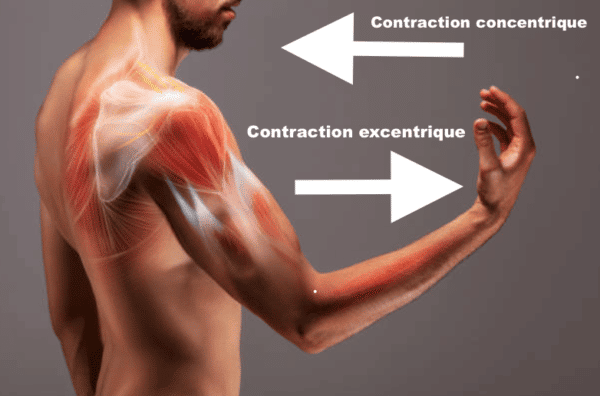Strength training works several muscles of the body. There are different training programs that use specific contractions for quality muscles. Among others, the contractions can be isometric, concentric or eccentric. In addition, there are other muscle contractions such as power and velocity. Discover useful information on these three types of contractions in bodybuilding.
What is concentric contraction?
The concentric contraction is used to contract the muscles. It is also called the positive phase, because it is the most used of all contractions. This type of contraction is what you use for all bench press movements but also for lifting weights or for training arm muscles, especially the biceps.
The goal of the concentric contraction is to contract a specific muscle to shorten it. Strength training calls this phase "the active moment", you will lift the weights and do intense exercises.
What are the advantages of concentric contraction?
This contraction technique has significant advantages for the quality of the muscles. After six exercises of the concentric contraction, your nervous system will be in top shape. However, the increase in the volume of your muscles will only be visible after at least 10 consecutive exercises.
In any case, your coach The only person who will tell you if you need to rest between workouts is the staff. It should be noted that each person is different in both power and strength. With a well-balanced training programEndurance can be felt after 15 repetitions. The exercises will be intense and you will feel weak. However, the concentric contraction is the phase where muscle mass will be developed.
In practice, for example when using a contraction to work the biceps, the flexion of the forearm will help the biceps to shrink and shape the muscles for more volume. The same is true when using a high bar. The phase where you climb towards the bar is the concentric contraction. The shortening of the muscles allows you to raise the bar with your body weight.
What is eccentric contraction?
Eccentric contraction or eccentric work is the opposite of concentric contraction. This is the so-called "negative" phase. This type of contraction is used to stretch muscles.
These will stretch away from the insertion points. The eccentric is the phase used to hold the weight, or to hold the load during the descent (for example, the negative phase during a bench press is the descent of the bar towards the chest).
Unlike the concentric contraction, the objective of this phase of contraction is only to manage to hold the load without causing incidents on the muscles. In this phase, avoid sudden movements and take the time to stretch the muscles slowly.
What are the advantages and disadvantages of eccentric contraction?
Eccentric contraction exercises will engage multiple muscle fibers. After the concentric contraction, this phase stretches the muscles that lifted the weight. Use this contraction to relax your muscles. This type of contraction is used in stretching exercises to relieve aches and pains.
The negative phase involves the descent in most exercises. For example, if for pull-ups with the high bar, you're not yet able to do several pull-ups in a row - you can, however, only do the downstrokes. You'll work your muscles in eccentric contraction, which will help you gain strength so that you'll later be able to do more pull-ups in the concentric phase.
This technique is therefore beneficial for exercising muscles to gain strength. Be aware that this slow phase requires more recovery time. Joints and muscles that relax with the weight will require more strength.
There are common physical exercises that use eccentric contraction. Among others, running downhill or the squat exercise in the negative phase to hold the descent. The principle is simple, the eccentric contraction uses less force than the resistance of our weight. However, the movements must be technically correct to stretch the muscles in order to control the descent without risk.
What is isometric contraction?
Isometric contraction is called static because it only allows certain muscles to contract. However, the attachment points and levers do not move. The objective is to immobilize the muscles and the weight carried. By being static, the force used by the muscle mass is very powerful.
The intensity of the isometric contractions will depend on each individual and their weight training. It should be noted that only a coach can determine the intensity of exercises for all levels. In addition, an isometric contraction exercise should not exceed 20 seconds and a duration of 3 to 6 minutes to perform all exercises.
What are the advantages of this type of contraction?
Workouts that involve isometric contraction use difficult positions. At first, some movements will be difficult to perform. However, the repetitions will allow the muscles to exceed their limits. Choose exercises that are easier to perform if you are new to bodybuilding. In any case, the most seasoned will be able to train with heavy loads to gain more strength.
Be aware that this static contraction only works the power of the muscles. The exercises will not necessarily increase muscle mass but they do strengthen the muscles. After an isometric contraction workout, it is important to take the necessary time to recover.
If the resting conditions of the muscles are not respected, the risk of muscle injuries and tendons is greater. The exercises are of short duration, it is recommended to follow these rules to avoid incidents. In addition to the many sheathing workouts, doing the chair exercise is one of the isometric contraction exercises.
What are the other most common muscle contractions?
There are other types of contractions that are used in strength training. Velocity is the set of movements that improves the speed of the muscles' reaction. The same goes for power, strength and speed will be worked together. The contraction will be faster in a concentric contraction exercise to give more power to the muscles.
There is also a technique called ultra-slow strength training that involves the joints. It is a question of carrying out the active contractions and the negative phase with slow movements. Moreover, a contraction can be dynamic, isotonic or even classic in the jargon of the bodybuilding world. In any case, it is wise to follow a training that is assisted by a bodybuilding expert.
Conclusion
As a general rule, muscle strengthening is done through these 3 contractions: concentric phase, eccentric phase and isometric phase. Depending on your program, the number of repetitions, series and tempos, the athlete or bodybuilder can work their muscles.
Do you want a complete bodybuilding program to follow?
Other articles to read :
How to successfully gain muscle?









